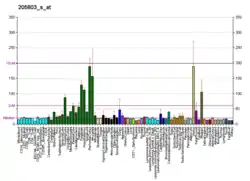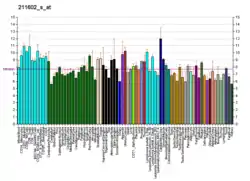TRPC1
Transient receptor potential canonical 1 (TRPC1) is a protein that in humans is encoded by the TRPC1 gene.[5][6]
Function
TRPC1 is an ion channel located on the plasma membrane of numerous human and animal cell types. [7] It is a nonspecific cation channel, which means that both sodium and calcium ions can pass through it. TRPC1 is thought to mediate calcium entry in response to depletion of endoplasmic calcium stores or activation of receptors coupled to the phospholipase C system. In HEK293 cells the unitary current-voltage relationship of endogenous TRPC1 channels is almost linear, with a slope conductance of about 17 pS. The extrapolated reversal potential of TRPC1 channels is +30 mV.[8] The TRPC1 protein is widely expressed throughout the mammalian brain and has a similar corticolimbic expression pattern as TRPC4 and TRPC5. [9][10] The highest density of TRPC1 protein is found in the lateral septum, an area with dense TRPC4 expression, and hippocampus and prefrontal cortex, areas with dense TRPC5 expression.[10]
History
TRPC1 was the first mammalian Transient Receptor Potential channel to be identified. In 1995 it was cloned when the research groups headed by Craig Montell and Lutz Birnbaumer were searching for proteins similar to the TRP channel in Drosophila. Together with TRPC3 they became the founding members of the TRPC ion channel family.[5][6]
Interactions
TRPC1 has been shown to interact with:
See also
References
- GRCh38: Ensembl release 89: ENSG00000144935 - Ensembl, May 2017
- GRCm38: Ensembl release 89: ENSMUSG00000032839 - Ensembl, May 2017
- "Human PubMed Reference:". National Center for Biotechnology Information, U.S. National Library of Medicine.
- "Mouse PubMed Reference:". National Center for Biotechnology Information, U.S. National Library of Medicine.
- Wes PD, Chevesich J, Jeromin A, Rosenberg C, Stetten G, Montell C (Oct 1995). "TRPC1, a human homolog of a Drosophila store-operated channel". Proceedings of the National Academy of Sciences of the United States of America. 92 (21): 9652–6. Bibcode:1995PNAS...92.9652W. doi:10.1073/pnas.92.21.9652. PMC 40860. PMID 7568191.
- Zhu X, Chu PB, Peyton M, Birnbaumer L (Oct 1995). "Molecular cloning of a widely expressed human homologue for the Drosophila trp gene". FEBS Letters. 373 (3): 193–8. doi:10.1016/0014-5793(95)01038-G. PMID 7589464. S2CID 21180202.
- Xu SZ, Beech DJ (Jan 2001). "TrpC1 is a membrane-spanning subunit of store-operated Ca(2+) channels in native vascular smooth muscle cells". Circulation Research. 88 (1): 84–7. doi:10.1161/01.res.88.1.84. PMID 11139478.
- Skopin A, Shalygin A, Vigont V, Zimina O, Glushankova L, Mozhayeva GN, Kaznacheyeva E (Feb 2013). "TRPC1 protein forms only one type of native store-operated channels in HEK293 cells". Biochimie. 95 (2): 347–53. doi:10.1016/j.biochi.2012.10.004. PMID 23079337.
- Fowler MA, Sidiropoulou K, Ozkan ED, Phillips CW, Cooper DC (2007). "Corticolimbic expression of TRPC4 and TRPC5 channels in the rodent brain". PLOS ONE. 2 (6): e573. Bibcode:2007PLoSO...2..573F. doi:10.1371/journal.pone.0000573. PMC 1892805. PMID 17593972.
- Cooper, Donald; Fowler, Melissa; Varnell, Andrew; Dietrich, A.; Birnbaumer, L.; Cooper, Donald (2012). "Deletion of the trpc1 gene and the effects on locomotor and conditioned place-preference responses to cocaine". Nature Precedings. doi:10.1038/npre.2012.7153.
- Yuan JP, Kiselyov K, Shin DM, Chen J, Shcheynikov N, Kang SH, Dehoff MH, Schwarz MK, Seeburg PH, Muallem S, Worley PF (Sep 2003). "Homer binds TRPC family channels and is required for gating of TRPC1 by IP3 receptors". Cell. 114 (6): 777–89. doi:10.1016/s0092-8674(03)00716-5. PMID 14505576. S2CID 10552676.
- Tsiokas L, Arnould T, Zhu C, Kim E, Walz G, Sukhatme VP (Mar 1999). "Specific association of the gene product of PKD2 with the TRPC1 channel". Proceedings of the National Academy of Sciences of the United States of America. 96 (7): 3934–9. Bibcode:1999PNAS...96.3934T. doi:10.1073/pnas.96.7.3934. JSTOR 47742. PMC 22398. PMID 10097141.
- Mehta D, Ahmmed GU, Paria BC, Holinstat M, Voyno-Yasenetskaya T, Tiruppathi C, Minshall RD, Malik AB (Aug 2003). "RhoA interaction with inositol 1,4,5-trisphosphate receptor and transient receptor potential channel-1 regulates Ca2+ entry. Role in signaling increased endothelial permeability". The Journal of Biological Chemistry. 278 (35): 33492–500. doi:10.1074/jbc.M302401200. PMID 12766172.
- Strübing C, Krapivinsky G, Krapivinsky L, Clapham DE (Oct 2003). "Formation of novel TRPC channels by complex subunit interactions in embryonic brain". The Journal of Biological Chemistry. 278 (40): 39014–9. doi:10.1074/jbc.M306705200. PMID 12857742.
- Xu XZ, Li HS, Guggino WB, Montell C (Jun 1997). "Coassembly of TRP and TRPL produces a distinct store-operated conductance". Cell. 89 (7): 1155–64. doi:10.1016/s0092-8674(00)80302-5. PMID 9215637. S2CID 15275438.
- Hofmann T, Schaefer M, Schultz G, Gudermann T (May 2002). "Subunit composition of mammalian transient receptor potential channels in living cells". Proceedings of the National Academy of Sciences of the United States of America. 99 (11): 7461–6. Bibcode:2002PNAS...99.7461H. doi:10.1073/pnas.102596199. PMC 124253. PMID 12032305.
Further reading
- Rychkov G, Barritt GJ (2007). "TRPC1 Ca(2+)-permeable channels in animal cells". Handbook of Experimental Pharmacology. 179 (179): 23–52. doi:10.1007/978-3-540-34891-7_2. ISBN 978-3-540-34889-4. PMID 17217049. Cite journal requires
|journal=(help) - Ambudkar IS (Feb 2007). "TRPC1: a core component of store-operated calcium channels". Biochemical Society Transactions. 35 (Pt 1): 96–100. doi:10.1042/BST0350096. PMID 17233611.
External links
- TRPC1+protein,+human at the US National Library of Medicine Medical Subject Headings (MeSH)
- "TRIP Database". a manually curated database of protein-protein interactions for mammalian TRP channels.
This article incorporates text from the United States National Library of Medicine, which is in the public domain.






